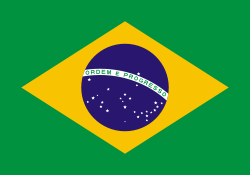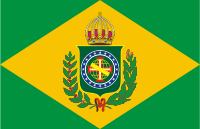Flag of Brazil
 |
|
| Name | Auriverde |
| Use | National flag and ensign. |
| Proportion | 7:10 |
| Adopted | November 19, 1889 (21-star version) May 11, 1992 (27-star version) |
| Design | A blue disc depicting a starry sky spanned by a curved band inscribed with the national motto, within a yellow rhombus, on a green field. |
| Designed by | Raimundo Teixeira Mendes |

The flag of Brazil has a green field on which a large yellow rhombus is centered. A blue circle is placed within the rhombus, with white stars of five different sizes and a curved white band running through it. The motto Ordem e Progresso ("Order and Progress") is inscribed in capital letters (of the same shade of green as the field) inside the band.
This flag is sometimes called Auriverde which means "(of) gold and green". The next-to-last stanza of Castro Alves' Navio Negreiro, for example, uses that term.[1]
The modern flag was officially adopted on November 19, 1889. The concept was the work of Raimundo Teixeira Mendes, with the collaboration of Miguel Lemos and Manuel Pereira Reis. The design was executed by Décio Vilares.
The current national flag and ensign maintains the same design with some minor changes. This 27-star version was adopted on May 12, 1992 (Law 8.421, May 11, 1992).
Contents |
History
Upon the proclamation of the First Republic, one of the leading figures in the process, lawyer and recently-appointed Minister of Finances and Taxation Ruy Barbosa, proposed a design for the national flag that was strongly inspired by the flag of the United States. This flag was used only for 4 days beginning November 15, 1889.

On November 19, 1889 the "Father of the Republic" and an acting president, field marshal Deodoro da Fonseca, vetoed the design, claiming that it was too much of a copy of another country's flag. Fonseca, who had been a royalist all his life and only led the coup that resulted in the proclamation of the Republic because he felt that the Emperor's actions were putting the country's stability in jeopardy, then suggested that the new Republican Flag should resemble the Imperial Flag. The decision was then made to replace only the royal crest with a new design (eventually decided to be the blue globe with the stars and the positivist motto). The objective in doing so was to reassert the continuity of the national unity during the transition from a Constitutional Monarchy to the Republican model. Raimundo Teixeira Mendes' design was presented to president Fonseca and promptly accepted.
Barbosa's design, however, was the basis for the state flags of Goiás, Piauí and Sergipe.
The largest flag regularly hoisted in the world is the Brazilian national flag flown in the Square of the Three Powers in the capital Brasilia. This flag weighs about 600 kilograms (1300 pounds) and has 7,000 square meters (70×100 m = 230×330 feet)
Colors
| Green | Yellow | Blue | White | |
|---|---|---|---|---|
| RGB | 0/146/62 |
248/193/0 |
40/22/111 |
255/255/255 |
| Hexadecimal | 00923E |
F8C100 |
28166F |
FFFFFF |
| CMYK | 100/0/100/0 |
0/10/100/0 |
100/70/0/20 |
0/0/0/0 |
| Pantone | PMS 355 |
PMS Yellow |
PMS 280 |
none |
CMYK and Pantone values based on files available for download from the Brazilian government's web portal (http://www.brasil.gov.br/pais/simbolos_hinos/ accessed 11 February 2008).
Symbolism

Brazil's current flag was inspired by the flag of the former Brazilian Empire. On the imperial flag, the green represented the Imperial House of Braganza of Pedro I, the first Emperor of Brazil, and the yellow represented the Habsburg Imperial Family of Empress Leopoldina, Pedro I's first wife. Thus, green and yellow are the colours of the Families of origin of the first imperial couple, founders of the Brazilian monarchy. The centre of the old imperial flag bore the Imperial Coat of Arms.
On the modern republican flag, the green background represents the forests, the yellow rhombus stands for the mineral wealth, and the blue circle, which replaced the coat of arms of the original flag, depicts the sky over Rio de Janeiro on the morning of November 15, 1889 – the day the Republic of Brazil was declared. It is shown as seen from outside of the celestial sphere (i.e. the view is mirrored).
The stars, whose position in the flag reflect the sky above Rio de Janeiro on November 15, 1889, represent the union's member-states - each star representing a specific state (which is not the case of the stars in the flag of the United States). The number of stars changes with the creation of new states and, since the early days of the republic, has risen from an original 21 stars to the current 27, standing for the 26 states and the Federal District.

The star that represents the Federal District is Sigma Octantis, a star whose position near the south celestial pole makes it visible across almost the whole country, all year round. In addition, given its polar position, all the other stars depicted on the flag trace appear to rotate around Sigma Octantis. Choosing this star to represent Brazil's capital is therefore particularly apt (although it is a much fainter star than any of the others).
The motto Ordem e Progresso ("Order and Progress") is inspired by Auguste Comte's motto of positivism: L’amour pour principe et l’ordre pour base; le progrès pour but ("Love as a principle and order as the basis; progress as the goal"). It was inserted because several of the people involved in the military coup d'état that deposed the monarchy and proclaimed Brazil a republic were followers of the ideas of Comte's thought.
Stars

The flag of Brazil contains 27 stars. The constellation of the Southern Cross is on the meridian (indicated by the number 6 in the diagram). To the south of it is Polaris Australis (Sigma Octantis, numbered 7), representing the Federal District. The motto appears on a band roughly coincident with the ecliptic. A single star lies above the band, representing the large northern state of Para, which straddles the Equator.
There is, more or less, a grouping of neighbour states within other constellations:-
- Crux represent the four southeastern states of São Paulo, Minas Gerais, Rio de Janeiro, Espírito Santo, plus the northeastern state of Bahia.
- Scorpius represent the eight other states of Northeastern Brazil; Sergipe, Alagoas, Pernambuco, Paraíba, Rio Grande do Norte, Ceará, Maranhão and Piauí.
- Triangulum Australe represents the three states of Southern Brazil; Rio Grande do Sul, Parana and Santa Catarina.
- The four lone stars of Procyon,Spica, Canopus and Sigma Octantis, represent Amazonas, Pará, Goiás and the Brazilian Federal District respectively.
- The two stars of Hydra were added when Mato Grosso do Sul and Acre achieved statehood,
- while Canis Major, originally just Sirius representing Mato Grosso, now represents the new Northern states of the Amazon basin also; Rondônia, Tocantins, Roraima and Amapá.
A list of constellations and stars on the map:
- Procyon (α Canis Minoris),
- Canis Major, with the largest star depicting Sirius,
- Canopus (α Carinae),
- Spica (α Virginis)
- Hydra
- Crux
- Sigma Octantis (σ Octantis; south pole star)
- Triangulum Australe
- Scorpius, with the largest star depicting Antares
The stars representing the Brazilian states (except Sigma Octantis which represents the capital or Federal District):
| State | Star | Constellation | Size (1=largest) |
|---|---|---|---|
| Alpha Canis Minoris (Procyon) | Canis Minor, the Little Dog | 1 | |
| Alpha Canis Majoris (Sirius) | Canis Major, the Great Dog | 1 | |
| Beta Canis Majoris (Mirzam) | Canis Major, the Great Dog | 3 | |
| Gamma Canis Majoris (Muliphen) | Canis Major, the Great Dog | 4 | |
| Delta Canis Majoris (Wezen) | Canis Major, the Great Dog | 2 | |
| Epsilon Canis Majoris (Adhara) | Canis Major, the Great Dog | 2 | |
| Alpha Virginis (Spica) | Virgo, the Virgin | 1 | |
| Alpha Scorpii (Antares) | Scorpius, the Scorpion | 1 | |
| Beta Scorpii (Graffias) | Scorpius, the Scorpion | 3 | |
| Epsilon Scorpii | Scorpius, the Scorpion | 2 | |
| Theta Scorpii (Sargas) | Scorpius, the Scorpion | 2 | |
| Iota Scorpii | Scorpius, the Scorpion | 3 | |
| Kappa Scorpii | Scorpius, the Scorpion | 3 | |
| Lambda Scorpii (Shaula) | Scorpius, the Scorpion | 2 | |
| Mu Scorpii | Scorpius, the Scorpion | 3 | |
| Alpha Hydrae (Alphard) | Hydra, the Water Serpent | 2 | |
| Gamma Hydrae | Hydra, the Water Serpent | 3 | |
| Alpha Crucis (Acrux) | Crux, the Southern Cross | 1 | |
| Beta Crucis (Mimosa) | Crux, the Southern Cross | 2 | |
| Gamma Crucis (Gacrux) | Crux, the Southern Cross | 2 | |
| Delta Crucis | Crux, the Southern Cross | 3 | |
| Epsilon Crucis | Crux, the Southern Cross | 4 | |
| Alpha Trianguli Australis | Triangulum Australe, the Southern Triangle | 2 | |
| Beta Trianguli Australis | Triangulum Australe, the Southern Triangle | 3 | |
| Gamma Trianguli Australis | Triangulum Australe, the Southern Triangle | 3 | |
| Alpha Carinae (Canopus) | Carina, the Keel of Argo | 1 | |
| Sigma Octantis (Polaris Australis) | Octans, the Octant | 5 |
Historical flags
The list below identifies other flags also used in Brazil prior to the foundation of the Republic.[2] Until 1822, the flags are all Portuguese.
Rejected flags
Many projects were created for the national flag, which is listed here the best known. It can be noted that existed among the first alternatives to the combination imperial tricolor flag, inspired by historical thesis of Carl Friedrich Philipp von Martius that the people of Brazil would be the founders of ethnic indigenous, European and African.[3]
References
- ↑ Navio Negreiro
- ↑ "Historical flags". Brazilian Army.
- ↑ Martius, Carl Friedrich Philipp von Como escrever a história do Brasil. page 381, 1844
See also
- Flags of Brazilian states
- Flag of Portugal
External links
- Brazil at Flags of the World
|
||||||||
|
||||||||||||||
|
||||||||